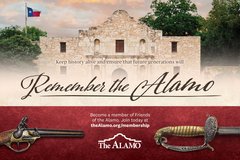During the past several weeks, archaeologists have been on-site at the Alamo conducting investigations as part of the Phase I work– which will improve pedestrian and vehicular traffic near the Alamo Complex — of the Alamo Plan and the preservation work of the Church and Long Barrack projects. Initial shovel testing in the southern portion of the Phase I project area discovered mostly modern materials consisting of plastics and lost coins. Recently, work shifted to the relocation of utilities under Crockett and Bonham Streets. These relocation efforts occurred in areas where modern utilities were understood to exist. These efforts will aid the upcoming work associated with moving or upgrading underground utilities in accordance with Phase I.
Archaeology Update — Phase 1 Investigations Resume

Archaeologists from Pape Dawson have been on-site to monitor the relocation of the utilities in case the work encountered intact archaeological deposits. During potholing, the archaeologists were able to document a substantial amount of disturbance that the installation of utilities has created over the years.

Along Crockett Street, the archaeologists completed and documented potholing activities to locate electrical and water lines in the street. The potholing process was conducted using a hydro-vac, which flushes water into a hole and then sucks the water and soils out. Solid objects, such as utility lines, remain in place. These potholes typically reached depths of just a few feet before encountering the utility lines. No significant archaeological deposits were encountered during the work on Crockett Street.
Along Bonham Street, the relocation of utilities used the hydro-vac method as well as the trenching method. A series of overlapping utilities at the north end of Bonham required the careful use of a backhoe to reveal the alignment. Archaeologists recorded that the upper 20 to 30 inches below the current surface consisted of asphalt and concrete. Below that, the excavations encountered sand and construction fill, typical of modern utility installations. Several artifacts that could date to the old utility installation were mixed into the old construction fill, including old mesquite blocks that were once used to pave the streets of San Antonio. Both artifact types could date from the late 1800s to early 1900s but were mixed into the fill, indicating that they were previously churned up by the installation of the modern utility lines


Excavations at this location in the north part of Bonham Street extended to approximately 10 to 11 feet below the current surface to locate a deeper sewer line. In addition to finding utility lines that were expected, the potholing along Bonham also encountered abandoned lines that were not on modern maps.

Utility relocation work appears to have been completed for now, as the design team is using the information gathered to plan for new alignments and tying into the existing installations.
The Texas Historical Commission (THC) approved a permit for the exhumation, limited non-destructive analysis, and re-interment of the previously encountered human remains to protect the discoveries from environmental degradation and to allow the architectural preservation of the Alamo to continue. Archaeologists from Raba Kistner have recently returned to the site to begin the exhumation excavations within the Church. All work conducted follows the scope of work and research approved by the THC and adheres to the previously established Human Remains Treatment Protocol that is being observed during all archaeological work on site. Once the exhumation process is completed, the historic architects will be able to complete their architectural investigations.
Archaeological work will continue at the Alamo for the next several weeks for both projects.


